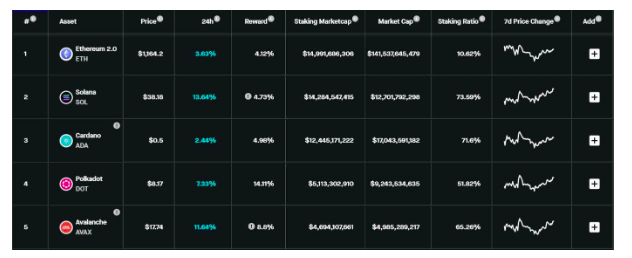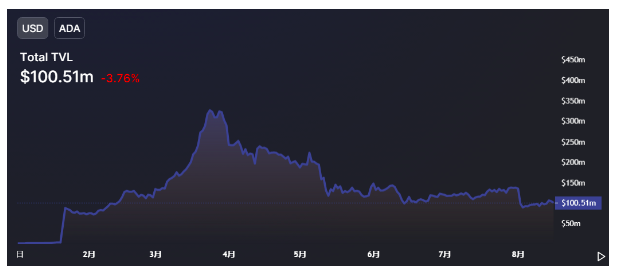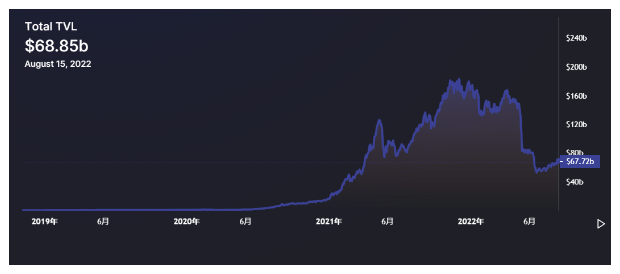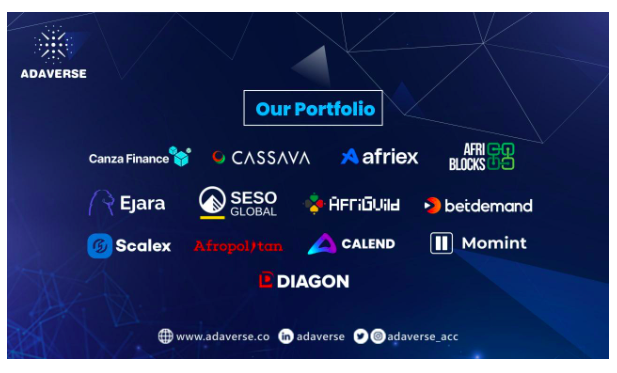
As an old-fashioned public chain project once regarded as a "strong competitor of Ethereum", Cardano has experienced several rounds of bulls and bears in the encryption industry. In fact, it has always been called the "elephant in the room" in the market:
Even though most of the encryption projects have recently been impacted by the continuous downturn of the secondary market, the total market value of Cardano is as high as 19 billion US dollars (CoinGecko data on August 16), ranking 6th in the market and even higher in the ranking of non-stable coins. It is second only to Bitcoin, Ethereum, and BNB.
Now that Cardano has entered the era of smart contracts since September last year, its ambitious goal of building a smart contract platform has been gradually implemented, especially with the expansion effect of Vasil Hardfork and the Layer 2 solution Hydra at the end of the year to completely realize the efficient operation of smart contracts. The rudimentary form of the Cardano ecology laid the foundation.
Can Cardano usher in the attention and influx of market funds, and is it possible to usher in a new narrative method and valuation space?
Veteran public chain Cardano: "The elephant in the room"
Cardano is an open-source PoS underlying public chain based on the Ouroboros Paros consensus protocol. The system adopts a "dual-chain" structure with a layered settlement layer + computing layer. The settlement layer is responsible for processing simple transfers and mining services, and the computing layer is responsible for processing smart contract interactions. .
At the same time, Cardano uses a modified version of UTXO (EUTXO) to support smart contracts, which is currently under steady development.
At the project construction level, the Cardano project has three main official participants, namely the Cardano Foundation, Cardano’s commercial company EMURGO (in addition to Cardano’s official global incubation investment fund) and the technology development company IOG (IOHK). Separation of Powers” working together on goals to support Cardano development, promotion and commercial adoption efforts:
The foundation is responsible for overseeing the development of Cardano and its ecology and community, IOG (IOHK) is responsible for the main development of the project, and Emurgo (Adaverse, etc.) is mainly for the incubation and investment projects of the Cardano ecosystem.
As of August 16, according to data from Staking Rewards, Cardano is currently the third largest staking network in the crypto world after Ethereum and Solana in terms of staking value.

In addition, ADApools statistics show that as of the time of publication, there are 3,178 pledge pools in the Cardano network, with more than 1.16 million principals, and a total pledge amount of 24.68 billion ADA, accounting for over 70% of the total ADA circulation.
In addition, since Cardano entered the smart contract stage in September last year, the signs of spontaneous evolution of the Cardano ecosystem have become more and more positive, covering the development layers of DEX, lending, derivatives, fixed income, algorithmic stable coins, asset synthesis, aggregators, etc. 6 times more diverse.
The most direct evidence is the gradual start of its DeFi total lock-up volume,Starting from 0, it slowly developed to about 100 million US dollars today, and began to form the initial prototype of its own ecology.

At the same time, in addition to Emurgo, as the Cardano global incubation investment fund with the same official endorsement, the newly established Adaverse has been deeply cultivating the Cardano ecology in the past two years. Relying on first-hand official incubation resources and funds to be invested, it has invested in More than a dozen high-quality projects on multiple tracks have formed a Cardano ecological matrix that has begun to take shape.
Cardano Development Roadmap
According to the Cardano roadmap, Cardano's development progress is divided into five main stages: Byron (foundation), Shelly (decentralization), Goguen (smart contract), Basho (scaling), and Voltaire (governance).

Currently, Cardano is in the fourth stage of BASHO (Scaling), that is, the development of scaling solutions is currently the focus of Cardano's development.
BYRON (Foundation)
Released in September 2017 as the first version of Cardano, BYRON allows users to use ADA on a blockchain network running the Ouroboros consensus protocol.
In addition, the BYRON stage also launched Daedalus, the official desktop wallet designed by IOHK, and Yoroi, a light wallet designed by Emurgo for fast transactions and daily use.
With the launch of the mainnet, this stage of development initially established the prototype of the Cardano community.
SHELLEY (decentralized)
Following the Byron Era, Cardano's SHELLEY phase is a period of network growth and development, and unlike the Byron Era which began with a single point in time of mainnet launch, the transition to SHELLEY is intended to be a smooth, low-risk transition without disruption Serve.
With the development of SHELLEY, more and more nodes are turned to be run by participants of the Cardano community, making Cardano more decentralized and enjoying stronger security and soundness.
SHELLEY also launched a delegation and incentive plan as a reward system to promote the adoption of the staking pool and the community, enabling users to stake their ADA to participate in network operations, which greatly reduces the system operating costs of the Cardano network.
This phase of development has greatly increased the participation of the Cardano community, while also strengthening the security and soundness of the Cardano network.
GOGUEN (smart contract)
With the integration of smart contracts, the GOGUEN stage is a big step forward for Cardano's network capabilities, increasing its ability to build a DApp ecosystem.
The GOGUEN phase has been working in parallel with SHELLEY, helping developers and users with non-technical backgrounds to create and execute functional smart contracts on the Cardano network.
Among them, Plutus is a huge breakthrough development. As a smart contract development language and execution platform using the functional programming language Haskell, compared with existing smart contract implementations, it improves the consistency and usability of the development experience.
The GOGUEN stage represents a profound change in the capabilities of the Cardano public chain, opening up a path for the development of enterprise-level, decentralized smart contract applications, and laying the foundation for the subsequent development of the BASHO and VOLTAIRE stages.
BASHO (expansion)
The BASHO phase that Cardano is currently in is an optimization phase aimed at improving the scalability and interoperability of the network. While previous development eras focused on decentralization and new features, BASHO focuses on improving the underlying performance of the Cardano network to better support the growth and adoption of high-transaction applications.
In addition, one of the core developments of BASHO will be the introduction of sidechains - as new blockchains interoperable with Cardano's main chain, with great potential to expand network capabilities.
VOLTAIRE (Governance)
In the design of Cardano, it is planned to realize the on-chain governance function in the Voltaire (Voltaire) stage, and the core of governance lies in voting decisions and raising funds. In the future, the capital system and decentralized voting software will be integrated into Cardano.
Currently, the IOHK team is working on related developments, including:
Cardano Improvement Proposals (CIP), a social communication system primarily used to describe formal, technology-oriented standards, norms, and processes, enabling transparency in on-chain governance;
Project Catalyst, a treasury system that combines proposal and voting procedures. Cardano will use this system to ensure that the project has a sustainable source of development funding. That is to say, in the future, Cardano will determine the source of project development funds through the financial system, such as deciding to use part of the transaction fees or issue new tokens as the project's continuous development fund through community voting.
The growing DApp ecology
In fact, Cardano has gradually formed an ecological structure dominated by DEX and NFT projects after completing the GOGUEN stage and officially entering the era of smart contracts. In addition, various types of applications such as DEX, Launchpad, and stable coins in the DeFi field have also been developed Appear.
MinswapMainly DEX, including various types of AMM liquidity pools, allowing users' transactions to pass through the most efficient pools, and then may be converted to DEX aggregators, and also includes IDO products.
WingRidersis an AMM-based decentralized exchange ecosystem that enables users to exchange native Cardano tokens in a decentralized manner without intermediaries or single points of failure, and it is also committed to being an infrastructure solution to support and enhance other projects.
SundaeSwapIt is the first AMM-based native decentralized exchange and liquidity provision agreement on Cardano, which adopts the innovative financing mechanism of Initial Stake Pool Offering (ISO) - the ISO mechanism is borrowed from Cardano's equity mining.
At present, these three DApps rank among the top three in Cardano's lock-up list, with a combined TVL of more than 100 million US dollars, almost supporting the entire Cardano DApp ecosystem.

In addition, there are also some diversified early projects that are in the testing stage, such asDjedIt is the algorithmic stable currency of Cardano ecological project COTI, which ensures price stability through smart contracts and will be used for DeFi operations. It also aims to become the ultimate currency for payment of Cardano's entire network transaction fees.
There are also a number of infrastructure and scaling solutions, such as Layer 2 network protocols that provide EVM capabilities for non-EVM compatible chainsMilkomeda, allowing users to transfer assets such as Bitcoin, Ethereum, and USDC, USDT on Ethereum to Milkomeda C1 and use EVM-compatible applications.
In general, according to the future ecosystem map previously announced by the Cardano community, it currently has project parties deploying it in multiple sectors such as lending, launchers, oracles, stablecoins, wallets, games, and NFTs.
Cardano's second half
According to statistics from DeFi Llama, as of August 16, 2022, the total locked-up volume of the DeFi ecosystem on Ethereum is about 38 billion US dollars.
At the same time, BNB Chain (formerly Binance Smart Chain), Solana, Avalanche, Arbitrum and other public chains or Layer 2 solutions have also attracted nearly 30 billion US dollars in funds, and their development has formed a scale that cannot be underestimated.

The wind started at the end of Qingping. Recently, the non-Ethereum smart contract public chain, as a diversified choice other than Ethereum, has a high probability of becoming an unavoidable key blue ocean track in the industry's next development.
text
Adaverse's global ecological incubation support
The most important thing for a public chain is to establish its own ecology. As mentioned above, as Cardano’s global incubation investment fund, Adaverse relies on the first-hand resources and investment funds of Cardano’s official team, Emurgo, to focus on incubating and investing in Cardano’s full-track ecological projects, covering more than a dozen high-quality projects on multiple tracks , forming a Cardano ecological matrix that has begun to take shape.
Next, Adaverse also plans to further expand into Asia while continuing to deploy in Africa, in order to achieve global deployment and application, and help Cardano incubate and discover high-quality ecological projects as much as possible on a global scale.

These projects cover remittance payment (Afriex), African real estate market (Seso Global), sports betting (BetDemand), African freelance market (AfriBlocks), blockchain infrastructure (Cassava Network) and other African and Cardano ecological layouts. Perfected the construction of Cardano ecology.
Next, Adaverse also plans to further expand into Asia while continuing to deploy in Africa, in order to achieve global deployment and application, and help Cardano incubate and discover high-quality ecological projects as much as possible on a global scale.
This means that in addition to obtaining financial support, Cardano’s start-up projects can quickly access the Carnado ecological matrix with the help of Adaverse’s resources to realize the synergy between liquidity and DApp products.
This means that in addition to obtaining financial support, Cardano’s start-up projects can quickly access the Carnado ecological matrix with the help of Adaverse’s resources to realize the synergy between liquidity and DApp products.
Next, Adaverse also plans to further expand into Asia while continuing to deploy in Africa, in order to achieve global deployment and application, and help Cardano incubate and discover high-quality ecological projects as much as possible on a global scale.
Layered consideration of security and performance
Cardano is a public chain that adopts the Ouroboros Paros consensus protocol. This is a chain-based PoS mechanism. The protocol has a certain degree of tolerance built in. As long as the vast majority of consensus participants in the entire network are honest, the default network is safe.
As mentioned above, there are currently 3,178 mining pools participating in the network consensus, with a mortgage rate of over 70% and a high degree of decentralization.
In addition, the reason why Cardano can achieve the same fast transaction speed and low transaction costs as other competing public chains while ensuring decentralization lies in its "dual-chain design":
It makes Cardano's settlement layer responsible for handling simple transfers and mining services, and the calculation layer is responsible for handling the interaction of smart contracts, so thatOn the premise of ensuring security, the efficiency of consensus is enhanced, the throughput capacity is maximized, and the two layers are organically combined to ensure that the value can be transferred safely and efficiently——The Cardano team has published related research papers, claiming that TPS can reach millions.
On the one hand, Vasil Hardfork is about to be completed, this upgrade will expand the blockchain capacity and speed up transactions; on the other hand, Hydra at the end of the year as a Layer 2 solution will ensure that each node achieves lower latency and less data storage.
More importantly, Hydra is also capable of executing smart contracts, which means that developers can easily build DApps and implement use cases for micropayments, voting, and other functions, so it is likely to become a catalyst for the real explosion of Cardano's ecology and truly promote its ecological TVL Achieve a wave of explosive growth with the transaction volume.
network stability
At present, besides Ethereum, there are many competitive public chains with superior underlying performance. Compared with Ethereum, the calculation and performance improvements are completely different, and a series of unique use cases can be realized for developers and the market. Therefore, in DeFi DApps such as DApps, NFT, and GameFi have developed a development path that is almost completely different from that of Ethereum.
It can be said that the successful precedents of Solana, Fantom, etc. have proved the necessity of high performance for the development of DeFi applications, NFT, GameFi and other DApps.
summary
summary
Everything in the past is prologue. In 2018 and 2021, we have ushered in the "public chain craze" with great momentum, and finally a new round of competitive public chains represented by Solana, Terra, Fantom, etc., whether it is at the basic framework level of technical architecture innovation or at the The actual application level of the perfect DApp gameplay has completely walked out of a different pace.
Of course, the competition of public chains has always been cruel. Cardano, which has just entered the smart contract era for less than a year, is currently in a very early stage.At present, the focus of the core team is still the development and improvement of the underlying infrastructure, and the improvement of the ecological construction will take a long time.
But this is also the key to subsequent breakthroughs, at least for now, just as Solana has Solana Ventures, Avalanche has Ava Labs,Twitter





